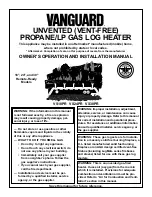
RESIDENTIAL GAS AND ELECTRIC WATER HEATER
SERVICE HANDBOOK
A.O. Smith Water Products Company
Training Department
©
2002
Ashland City, Tennessee
13
Residential Gas - continued
Electrical Testing– continued
Millivolt dropout test
through copper magnet winding and ECO (Emergency Cut Off)
Procedure
:
Move meter probe to upper ECO solder joint and ground
If …
… then
reading of at least 10 MV is not present
replace the control valve.
reading of more than 10 MV is present but,
gas to the pilot shuts off each time knob is
released
replace the control valve.
Safety drop out test
– the safety gas shutoff
should interrupt gas through
the valve when MV current
drops to 1-3 MV.
Procedures:
Meter still connected to upper ECO solder joint and
ground.
Turn Top Knob to “off” position
Millivolt output will decrease as thermocouple cools
If… …
then
internal safety does not activate between 1
and 3 MV (you will hear a “click” inside the
valve)
replace the control valve.
*internal safety does activate between 1 and
3 MV
valve is within tolerance and will interrupt gas
flow if pilot looses heat or ECO opens.
*Note: A “click” sound should be heard from the valve as the main gas interrupter snaps up to the
“closed” position.
Condensation
Flue gas products contain moisture. If these flue gas products are cooled to their “dew point”,
they become visible moisture – condensation.
Flue gas may become cooled by:
•
Cold supply air temperatures
•
Cool surfaces – generally, if tank water temperatures drop below 110
°
F, the flue pipe surface
and/or bottom tank head will be cool enough to cause condensation.
•
Increased combustion efficiency – higher thermal efficiency means that an increased amount
of heat is transferring from the flue gas into the water. If you transfer (approximately) 87.5%,
or more, the moisture in the flue gas will condense.
TO GROUND















































